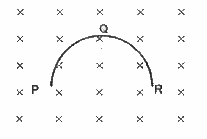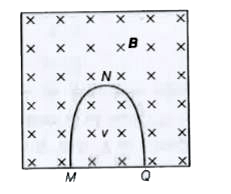A thin semicircular conducting ring of radius R is falling with its plane verticle in a horizontal magnetic inducting B. At the position MNQ, the speed of the ring is V and the potential difference developed across the ring is

(1.) zero
(2.)BcπR2/2
(3.) πRBV
(4.) 2RBV
zero
BvπR22 and M is at higher potential
πRBV and Q is at higher potential
2RBV and Q is higher potential
The correct Answer is:D
Induced motional emf in MNQ is equivalent to the motional emf in an imaginary wire MQ i.e., eMNQ=eMQ=Bvl=Bv(2R)
[l=MQ=2R]
Therefore potential difference developed across the ring is 2RBV with Q at higher potential.
eMNQ=eMQ=Bvl=Bv(2R)
[l=MQ=2R]
Topper's Solved these Questions
- ELECTROMAGNETIC INDUCTIONBOOK - RESONANCE ENGLISHCHAPTER - ELECTROMAGNETIC INDUCTIONEXERCISE - Exercis-2 PART 1
14 Videos
- ELECTROMAGNETIC INDUCTIONBOOK - RESONANCE ENGLISHCHAPTER - ELECTROMAGNETIC INDUCTIONEXERCISE - Exercis-2 PART 2
17 Videos
- ELECTROMAGNETIC INDUCTIONBOOK - RESONANCE ENGLISHCHAPTER - ELECTROMAGNETIC INDUCTIONEXERCISE - Exercis-1
63 Videos
- ELECTRODYNAMICSBOOK - RESONANCE ENGLISHCHAPTER - ELECTRODYNAMICSEXERCISE - Advanced level problems
31 Videos
- ELECTROSTATICSBOOK - RESONANCE ENGLISHCHAPTER - ELECTROSTATICSEXERCISE - HLP
40 Videos
Similar Questions
As shown in figure, P and Q are two co-axial conducting loops separated by some distance. When the switch S is closed, a clockwise current IP flows in P (as seen by E) and an induced current IQ1 flows in Q. The switch remains closed for a long time. When S is opened, a current IQ2 flows in Q.
Then, the directions of IQ1 and IQ2 (as seen by E) are

View SolutionA plane spiral with a great number N of turns wound tightly to one another is located in a uniform magnetic field perpendicular to the spiral's plane.The outside radius of the spiral's turns is equal to a and inner radius is zero.The magnetic induction varies with time as B=B0sinωt, where B0 and ω are constants.The amplitude of emf induced in the spiral is εim=1xπa2NωB0.Find out value of x.
View SolutionIf flux in a coil changes by Δϕ, and the resistance of the coil is R,prove that the charge flown in the coil during the flux change is ΔϕR.(Note :It is independent of the time taken for the change is flux)
View SolutionCalculate the magnetic moment (in Am2 ) of a thin wire with a current I = 8A, wound tightly on half a torus (see figure). The diameter of the cross section of the torus is equal to d = 5 cm, and the number of turns is N = 500.

View SolutionAn electrometer consister of a fixed vertical metal bar OB at the top of which is attached a thin rod OA which gets deflected from the bar under the action of an electric charge (fig.). The rod can rotate in vertical plane about fixed horizontal axis passing through O. The reading is taken on a quadrant graduated in degrees. The length of the rod is l and its mass is m. what will be the charge when the rod of such an electrometer is deflected through an angle α in equilibrium. Find the answer using the following two assumptions :
The charge on the electrometer is equally distributed between the bar & the rod and the charges are concentrated at point A on the rod & at point B on the bar.

View SolutionA thin semi-circular conducting ring of radius R is falling with its plane verticle in horizontal magnetic induction (→B). At the position MNQ the speed of the ring is v, and the potential difference developed across the ring is

View SolutionA thin semicircular conducting ring of radius R is falling with its plane vertical in a horizontal magnetic induction B. At the position MNQ, the speed of the ring is V and the potential difference developed across the ring is

View SolutionA thin semicircuilar conducting ring (PQR) of radius r is falling with its plane vertical in a horizontal magnetic field B, as shown in Fig. The potential difference developed across the ring when its speed is upsilon , is
View SolutionA thin semicircular conducting ring of radius R is falling with its plane vertical in a horizontal magnetic induction B. At the position MNQ shown in the fig, the speed of the ring is V. The potential difference developed across the semicircular ring is
View Solutionr त्रिज्या की एक पतली अर्धवृत्ताकार चालक रिंग (वलय) PQR किसी क्षैतिज चुम्बकीय क्षेत्र B में गिर रही है । गिरते समय इसका समतल आरेख में दर्शाये गए अनुसार ऊर्ध्वाधर रहता है । जब गिरते हुए रिंग की चाल v है तो , इसके दो सिरों के बीच विकसित विभवान्तर है :

View Solutionr त्रिज्या की पतली अर्द्धवृत्ताकार रिंग PQR , किसी क्षैतिज चुम्बकीय क्षेत्र B में गिर रही है | गिरते समय इसका समतल , आरेख में दर्शाये गए अनुसार, ऊर्ध्वाधर रहता है | जब गिरती हुई रिंग की चाल v है तो इसके दो सिरों के बीच विकसित विभवांतर होगा -

View Solutionएक अर्द्धवृत्ताकार वलय जिसकी त्रिज्या R है अपने तल के लम्बवत क्षैतिज चुम्बकीय क्षेत्र B में गिर रही है। MNQ स्थिति पर वलय की चाल है तथा वलय में विभवान्तर है

View SolutionA thin semi-circular conducting ring (PQR) of radius r is falling with its plane vertical in a horizontal magnetic field B, as shown in the figure. The potential difference developed across the ring when its speed v, is
View SolutionA thin circular -conducting ring having N turns of radius R is falling with its plane vertical in a horizontal magnetic field B . At the position MNQ the speed of ring is v the induced e.m.f developed across the ring is
View SolutionA thin semicircular conductor ring with R diameter, horizontal magnetic field as shown in Fig. IV.13 vec B Is falling while its bottom is vertical. The velocity of the ring in position MNQ is v. The potential generated at the ends of the ring is
View Solutionत्रिज्या R की एक पतली अर्द्धवृत्ताकार धात्विक वलय क्षैतिज चुम्बकीय प्रेरण B में इस प्रकार गिर रही है कि इसका तल ऊर्ध्वाधर रहता है। जब यह वलय MNQ की स्थिति में पहुँचती है तब इसका वेग । है। इस समय अर्द्धवृत्ताकार वलय में उत्पन्न विभवान्तर होगा

View Solution
